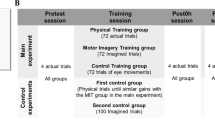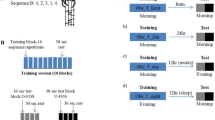Abstract
Motor learning is a process that extends beyond training sessions. Specifically, physical practice triggers a series of physiological changes in the CNS that are regrouped under the term “consolidation” (Stickgold and Walker 2007). These changes can result in between-session improvement or performance stabilization (Walker 2005). In a series of three experiments, we tested whether consolidation also occurs following observation. In Experiment 1, participants observed an expert model perform a sequence of arm movements. Although we found evidence of observation learning, no significant difference was revealed between participants asked to reproduce the observed sequence either 5 min or 24 h later (no between-session improvement). In Experiment 2, two groups of participants observed an expert model perform two distinct movement sequences (A and B) either 10 min or 8 h apart; participants then physically performed both sequences after a 24-h break. Participants in the 8-h group performed Sequence B less accurately compared to participants in the 5-min group, suggesting that the memory representation of the first sequence had been stabilized and that it interfered with the learning of the second sequence. Finally, in Experiment 3, the initial observation phase was replaced by a physical practice phase. In contrast with the results of Experiment 2, participants in the 8-h group performed Sequence B significantly more accurately compared to participants in the 5-min group. Together, our results suggest that the memory representation of a skill learned through observation undergoes consolidation. However, consolidation of an observed motor skill leads to distinct behavioural outcomes in comparison with physical practice.







Similar content being viewed by others
Notes
\( AE = \sum {{\frac{{\left| {x_{i - 1200} } \right|}}{n}}} \) where x i is the total movement time on trial i and n is the total number of sequences executed.
\( VE = \sqrt {\sum {{\frac{{\left( {x_{i} - M} \right)^{2} }}{n}}} } \) where x i is the total movement time on trial i, M is the mean total movement time, and n is the total number of sequences executed.
\( RMSE = \sqrt {{\frac{{\sum {\left( {\frac{yi}{TMT} - 0.25} \right)} }}{4}}} \) where y i is the movement time of segment i and TMT is the total movement time of the trial.
References
Adams JA (1971) A closed-loop theory of motor learning. J Mot Behav 3:111–150
Ashford D, Bennett SJ, Davids K (2006) Observational modeling effects for movement dynamics and movement outcome measures across differing task constraints: a meta-analysis. J Mot Behav 38:185–205
Blandin Y, Proteau L (2000) On the cognitive basis of observational learning: development of mechanisms for the detection and correction of errors. Q J Exp Psychol 53A:846–867
Blandin Y, Lhuisset L, Proteau L (1999) Cognitive processes underlying observational learning of motor skills. Q J Exp Psychol 52A:957–979
Brashers-Krug T, Shadmehr R, Bizzi E (1996) Consolidation in human motor memory. Nature 382:252–254
Brown LE, Wilson ET, Gribble PL (2009) Repetitive transcranial magnetic stimulation to the primary motor cortex interferes with motor learning by observing. J Cogn Neurosci 21:1013–1022
Cohen J (1988) Statistical power analysis for the behavioral sciences. Lawrence Erlbaum Associates, New Jersey
Cross ES, Kraemer DJM, Hamilton AFC, Kelley WM, Grafton ST (2009) Sensitivity of the action observation network to physical and observational learning. Cereb Cortex 19:315–326
Crossman ERFW (1959) A theory of the acquisition of speed skill. Ergonomics 2:153–166
Debarnot U, Creveaux T, Collet C, Doyon J, Guillot A (2009a) Sleep contribution to motor memory consolidation: a motor imagery study. Sleep 32:1559–1565
Debarnot U, Creveaux T, Collet C, Gemignani A, Massarelli R, Doyon J, Guillot A (2009b) Sleep-related improvements in motor learning following mental practice. Brain Cogn 69:398–405
Debarnot U, Maley L, De Rossi D, Guillot A (2010) Motor interference does not impair the memory consolidation of imagined movements. Brain Cogn 74:52–57
Fischer S, Hallschmid M, Elsner AL, Born J (2002) Sleep forms memory for finger skills. Proc Natl Acad Sci USA 99:11987–11991
Fitts PM (1954) Adaptation of aimed arm movements to sensorimotor discordance: evidence for direction-dependant gain control. J Exp Psychol 47:381–391
Fitts PM (1964) Perceptual-motor skills learning. In: Melton AW (ed) Categories of human learning. Academic Press, New York
Grèzes J, Decety J (2001) Functional anatomy of execution, mental simulation, observation, and verb generation of actions: a meta-analysis. Hum Brain Mapp 12:1–19
Hill S, Tononi G, Ghilardi AF (2008) Sleep improves the variability of motor performance. Brain Res Bull 76:605–611
Hoffman KL, McNaughton BL (2002) Coordinated reactivation of distributed memory traces in primate neocortex. Science 297:2070–2073
Holroyd CB, Coles MGH (2002) The neural basis of human error processing: reinforcement learning, dopamine, and the error-related negativity. Psychol Rev 109:679–709
Iacoboni M, Dapretto M (2006) The mirror neuron system and the consequences of its dysfunction. Nat Rev Neurosci 7:942–951
Jay TM (2003) Dopamine: a potential substrate for synaptic plasticity and memory mechanisms. Prog Neurobiol 69:375–390
Jeannerod M (1999) To act or not to act: perspectives on the representation of actions. Q J Exp Psychol 1999:1–29
Ji D, Wilson MA (2007) Coordinated memory replay in the visual cortex and hippocampus during sleep. Nat Neurosci 10:100–107
Karni A, Meyer G, Jezzard P, Adams MM, Turner R, Ungerleider LG (1995) Functional MRI evidence for adult motor cortex plasticity during motor skill learning. Nature 377:155–158
Kelly SW, Burton AM, Riedel B, Lynch E (2003) Sequence learning by action and observation: evidence for separate mechanisms. Br J Psychol 94:355–372
Kleim JA, Hogg TM, VanderBerg PM, Cooper NR, Bruneau R, Remple M (2004) Cortical synaptogenesis and motor map reorganization occur during late, but not early, phase of motor skill learning. J Neurosci 24:628–633
Krakauer JW, Shadmehr R (2006) Consolidation of motor memory. Trends Neurosci 29:58–64
Krakauer JW, Ghilardi MF, Ghez C (1999) Independent learning of internal models for kinematic and dynamic control of reaching. Nat Neurosci 2:1026–1031
Krakauer JW, Ghez C, Ghilardi MF (2005) Adaptation to visuomotor transformations: consolidation, interference, and forgetting. J Neurosci 25:473–478
Kuriyama K, Stickgold R, Walker MP (2004) Sleep-dependent learning and motor-skill complexity. Learn Mem 11:705–713
McGaugh JL (2000) Memory—a century of consolidation. Science 287:248–251
Muellbacher W, Ziemann U, Wissel J, Dang N, Kofler M, Facchini S, Boroojerdi B, Poewe W, Hallet M (2002) Early consolidation in human primary motor cortex. Nature 415:640–644
Press DZ, Casement MD, Pascual-Leone A, Robertson EM (2005) The time course of off-line motor sequence learning. Cogn Brain Res 25:375–378
Rizzolatti G, Craighero L (2004) The mirror-neuron system. Annu Rev Neurosci 27:169–192
Robertson EM, Cohen DA (2006) Understanding consolidation through the architecture of memories. Neuroscientist 12:261–271
Robertson EM, Pascual-Leone A, Miall RC (2004) Current concepts in procedural consolidation. Nat Rev Neurosci 5:576–582
Sanes JN, Donoghue JP (2000) Plasticity and primary motor cortex. Annu Rev Neurosci 23:393–415
Schmidt RA (1975) A schema theory of discrete motor skill learning. Psychol Rev 82
Shadmehr R, Holcomb HH (1997) Neural correlates of motor memory consolidation. Science 277:821–825
Shadmehr R, Holcomb HH (1999) Inhibitory control of competing motor memories. Exp Brain Res 126:235–251
Shea JB, Morgan RL (1979) Contextual interference effects on the acquisition, retention, and transfer of a motor skill. J Exp Psychol [Hum Learn] 5:179–187
Stefan K, Classen J, Celnik P, Cohen LG (2008) Concurrent action observation modulates practice-induced motor memory formation. Eur J Neurosci 27:730–738
Stevens J (1992) Applied multivariate statistics for the social sciences. L. Erlbaum Associates, Hillsdale, N.J
Stickgold R, Walker MP (2007) Sleep-dependent memory consolidation and reconsolidation. Sleep Med 8:331–343
Tabachnick BG, Fidell LS (2007) Using multivariate statistics. Montreal, Boston
Tononi G, Cirelli C (2003) Sleep and synaptic homeostasis: a hypothesis. Brain Res Bull 62:143–150
Trempe M, Proteau L (2010) Distinct consolidation outcomes in a visuomotor adaptation task: off-line leaning and persistent after-effect. Brain Cogn 73:135–145
Van Der Werf YD, Van Der Helm E, Schoonheim MM, Ridderikhoff A, Van Someren EJW (2009) Learning by observation requires an early sleep window. Proc Natl Acad Sci USA 106:18926–18930
Walker MP (2005) A refined model of sleep and the time course of memory formation. Behav Brain Sci 28:51–104
Walker MP, Stickgold R (2005) It’s practice, with sleep, that makes perfect: implications of sleep-dependent learning and plasticity for skill performance. Clin Sports Med 24:301–317
Walker MP, Brakefield T, Morgan A, Hobson JA, Stickgold R (2002) Practice with sleep makes perfect: sleep-dependent motor skill learning. Neuron 35:205–211
Walker MP, Brakefield T, Hobson JA, Stickgold R (2003) Dissociable stages of human memory consolidation and reconsolidation. Nature 425:616–620
Walker MP, Stickgold R, Alsop D, Gaab N, Schlaug G (2005) Sleep-dependent motor memory plasticity in the human brain. Neuroscience 133:911–917
Wilson MA, McNaughton BL (1994) Reactivation of hippocampal ensemble memories during sleep. Science 265:676–679
Acknowledgments
This work was supported by a Discovery grant (L.P.) and a scholarship (M. T.) provided by the Natural Sciences and Engineering Research Council of Canada.
Author information
Authors and Affiliations
Corresponding author
Rights and permissions
About this article
Cite this article
Trempe, M., Sabourin, M., Rohbanfard, H. et al. Observation learning versus physical practice leads to different consolidation outcomes in a movement timing task. Exp Brain Res 209, 181–192 (2011). https://doi.org/10.1007/s00221-011-2540-3
Received:
Accepted:
Published:
Issue Date:
DOI: https://doi.org/10.1007/s00221-011-2540-3




